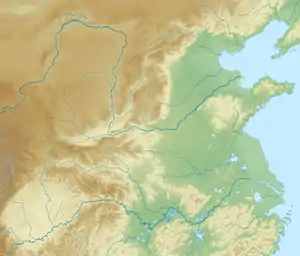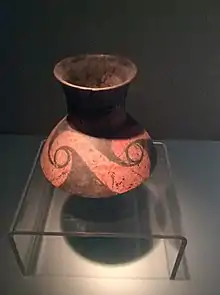Taosi
Taosi (Chinese: 陶寺; pinyin: Táosì) is an archaeological site in Xiangfen County, Shanxi, China. Taosi is considered to be part of the late phase of the Longshan culture in southern Shanxi, also known as the Taosi phase (2300 BC to 1900 BC).
陶寺 | |
 Location in north China | |
| Location | China |
|---|---|
| Region | Shanxi |
| Coordinates | 35°53′26.17″N 111°29′49.82″E |
| Area | 280 ha |
| History | |
| Founded | c. 2300 BC |
| Abandoned | c. 1900 BC |
| Cultures | Longshan culture |

Archaeology
Taosi was surrounded by a gigantic rammed-clay enclosure. This was discovered from 1999 to 2001 by the archaeologists from the Institute of Archaeology, Chinese Academy of Social Sciences; they attributed this wall to the Middle Taosi period (4,100 to 4,000 BP). Rectangular in form with an inner area of 280 ha.[1]
An internal rammed-earth wall separated the residential and ceremonial areas of the elite from the areas inhabited by commoners, signifying the development of a stratified society.[2][3]
A painted stick discovered from a prehistoric dating from 2300 BCE excavated at the astronomical site of Taosi is the oldest gnomon known in China.[4] The gnomon was widely used in ancient China from the second century BC onward in order determine the changes in seasons, orientation, and geographical latitude. The ancient Chinese used shadow measurements for creating calendars that are mentioned in several ancient texts. According to the collection of Zhou Chinese poetic anthologies Classic of Poetry, one of the distant ancestors of King Wen of the Zhou dynasty used to measure gnomon shadow lengths to determine the orientation around the 14th-century BC.[5][6][7]
The Huaxia settlement outgrew the perimeter of the wall. The settlement is the largest Longshan site discovered in the Linfen basin, Yellow River basin area, possibly a regional center. The settlement represents the most political system on the Central Plains at the time. The polites in the Taosi site are considered an advanced chiefdom, but may not have not developed into a higher political organization. It was not the Taosi polites but, the less socially complex Central Plains Longshan sites, the scattered, multi-system competing systems that gave rise to early states in this region.[8]
Ancient "observatory"
Taosi also contained an astronomical observatory, the oldest in East Asia.[9]
This was discovered in 2003-2004. Archaeologists unearthed a Middle Taosi period semi-round foundation just beside southern wall of the Middle Taosi enclosure, which could be used for astronomical observations. The structure consists of an outer semi-ring-shaped path, and a semi-round rammed-earth platform with a diameter of about 60 m. The platform is 42m in diameter and over 1000 sq m in area, and can be reconstructed as a three-level altar.
On the top of the altar, an arch-shaped rammed earth foundation facing the east with 12 slots, each 0.15 to 0.2 m wide and 1.4 m between each other were discovered; standing in the center of the altar and watching through the slots, one can find that most of slots respectively orientate to a given point of the Chongfen Mountain to the east.[10]
In a given period in the ancient times, the midwinter sunrise of the winter solstice would have been in the middle of the second eastern slot, the midsummer sunrise of the summer solstice would have been in the middle of the westmost slot, and during the seasons the sun would rise within each of the slots from west to east, marking the passage of time between the winter solstice and the summer solstice. This means these slots shares a similar function of the Thirteen Towers of the Chankillo Observatory, and they might have been intentionally constructed in for astronomical observation of the sunrise on a particular point in a given day, in order to establish the local solar calendar, which is crucial for the practice of agriculture at that time.[11]
Necropolis
The cemetery of Taosi covered an area of 30,000 square meters (3ha) at its height.[12]
The cemetery contained over 1,500 burials. The burials at Taosi were highly stratified (the most stratified of Longshan sites), with burial wealth concentrated in the graves of a few males (nine large graves). The largest graves were placed in separated rooms with murals, had a large cache of grave goods (some with over 200 objects, including jades, copper bells, wooden and crocodile skin musical instruments); middle-size graves featured painted wooden coffins and luxury objects; most of the small graves did not have grave goods.[13] A single bronze bell was also found at a Taosi grave.
Emperor Yao connection
Several Chinese archaeologists postulate that Taosi was the site where the state of Youtang (有唐) being conquered by Emperor Yao, (traditionally c. 2356–2255 BC) who later instituted Taosi as the capital.[14]
In Chinese classic documents Yao Dian (Document of Yao) in Shang Shu (Book of Ancient Time), and Wudibenji (Records for the Five Kings) in Shiji (Historic Records), King Yao assigned astronomic officers to observe celestial phenomena, including time and position of sunrise, sunset, and stars in culmination, in order to systematically establish a solar calendar and a lunar calendar with 366 days a year with leap month. The observatory found at Taosi coincides with these records.[15] It is theorized that the city collapsed with a rebellion against the ruling class.[16][17][18]
On the other hand, some Western scholars assert that emperor Yao was a mythical figure.
Notes
- He Nu, Wu Jiabi (2005), Astronomical date of the "observatory" at Taosi site. Institute of Archaeology, Chinese Academy of Social Sciences (IA CASS)
- He 2013; Ren 1998; Zhongguo et al. 2005
- Higham, C.; Higham, T.; Ciarla, R.; Douka, K.; Kijngam, A.; Rispoli, F. (2011). "The Origins of the Bronze Age of Southeast Asia". Journal of World Prehistory. 24 (4): 227. doi:10.1007/s10963-011-9054-6. S2CID 162300712.
- Li, Geng (2014). "Gnomons in Ancient China". In Ruggles, Clive (ed.). Handbook of Archaeoastronomy and Ethnoastronomy. Springer New York (published July 7, 2014). p. 2095. ISBN 978-1-4614-6141-8.
- Li, Geng (9 July 2017). Handbook of Archaeoastronomy and Ethnoastronomy. p. 2095. Bibcode:2015hae..book.2095L. doi:10.1007/978-1-4614-6141-8_219 – via NASA ADS.
- Li, Geng (2014). "Gnomons in Ancient China". In Ruggles, Clive (ed.). Handbook of Archaeoastronomy and Ethnoastronomy. Springer New York (published July 7, 2014). pp. 2095–2096. ISBN 978-1-4614-6141-8.
- The 2nd-century Chinese book Nine Chapters on the Mathematical Art claims gnomons were used by the Duke of Zhou (11th century BC). Laertius, Diogenes. "Life of Anaximander".
- Liu, Li (2005). The Chinese Neolithic: Trajectories to Early States. p. 191.
- David Pankenier, et al. (2008), The Xiangfen, Taosi site: A Chinese Neolithic 'observatory'?. Archaeologica Baltica 10
- He Nu, Wu Jiabi (2005), Astronomical date of the "observatory" at Taosi site. The Institute of Archaeology, Chinese Academy of Social Sciences (IA CASS)
- He Nu, Wu Jiabi (2005), Astronomical date of the "observatory" at Taosi site. The Institute of Archaeology, Chinese Academy of Social Sciences (IA CASS)
- 书略*追远略*古DNA显示:现代汉族就是古代中原人的直系后代 Archived 2011-07-18 at the Wayback Machine
- K.C.Chang in Cambridge History of Ancient China, 1999, p.60.
- 尧的政治中心的迁移及其意义 Archived 2011-09-06 at the Wayback Machine
- He Nu, Wu Jiabi (2005), Astronomical date of the "observatory" at Taosi site. The Institute of Archaeology, Chinese Academy of Social Sciences (IA CASS)
- 论陶寺古城的发展阶段与性质 Archived 2011-07-07 at the Wayback Machine
- 从陶寺遗存看中国早期国家之形成——中国早期文明研究札记之五 Archived 2011-07-11 at the Wayback Machine
- 从陶寺遗址考古收获看中国早期国家特征
References
| Wikimedia Commons has media related to Taosi. |
- Chang, Kwang-chih. The Archaeology of Ancient China, ISBN 0-300-03784-8
- He, Nu and Wu, Jiabi. Astronomical date of the "observatory" at Taosi site
- Higham, Charles, The Bronze Age of Southeast Asia, ISBN 0-521-56505-7
- Liu, Li. The Chinese Neolithic: Trajectories to Early States, ISBN 0-521-81184-8
